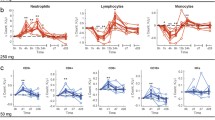Abstract
To understand how corticosteroids act; a characterization of their effects on lymphocytes is necessary. The effect of in vivo corticosteroids on lymphocyte subpopulations, their surface molecules and externalization of phosphatidylserine (apoptosis) is examined. In a crossover study, a single, intravenous dose of 2 mg/kg prednisolone or saline was given to six male adult human volunteers. Blood samples were withdrawn before and 30 min, 2, 5, 23 and 29 h thereafter. Lymphocyte subsets were determined by FACS analysis. Externalization of phosphatidylserine was measured by Annexin-V; cell fragments were excluded by propidium iodide staining. Lymphocyte number decreased from 2,007 ± 473 to 634 ± 119 μl after 5 h and rose to 3,112 ± 436 μl after 23 h. CD4, CD8 and B cell counts declined significantly after 5 h (P ≤ 0.01). The expression of CD28 or CD95 on T cells and the natural killer cells were unaffected. There was a significant rebound of lymphocyte numbers above baseline 23 h after prednisolone. At baseline 9.9 ± 3.8% of cells in the lymphocyte gate did not stain for CD3, CD20 or CD56 (referred to as “null cells”). 5 h after application of prednisolone, there was a significant increase of “null cells” (28 ± 12%, P = 0.018). The percentage of phosphatidylserine positive CD4 cells rose from 8.1 ± 3.3 to 19.8 ± 8% after intravenous prednisolone, while the percentage of phosphatidylserine positive CD8, B and NK cells remained largely unchanged. Prednisolone induces a most significant depletion of CD4 cells, which to some degree is associated with apoptosis. The net increase of lymphocyte numbers 23 h after prednisolone application may be a beneficial late effect of a single i.v. prednisolone shot.




Similar content being viewed by others
Abbreviations
- CD:
-
Cluster of differentiation
- DNA:
-
Deoxy ribonucleotide acid
- FACS:
-
Fluorescence activating cell sorting
- FITC:
-
Fluorescein isothiocyanate
- GCR:
-
Glucocorticoid receptor
- NK-cells:
-
Natural killer cells
- PE:
-
Phycoerythrin
- PS:
-
Phosphatidylserine
- SD:
-
Standard deviation
References
Almawi WY (2001) Molecular mechanisms of glucocorticoid effects. Mod Asp Immunobiol 2:78–82
Benito JM, Lopez M, Martin JC, Lozano S, Martinez P, Gonzalez-Lahoz J, Soriano V (2002) Differences in cellular activation and apoptosis in HIV-infected patients receiving protease inhibitors or nonnucleoside reverse transcriptase inhibitors. AIDS Res Hum Retroviruses 18:1379–1388
Boss B, Neeck G, Engelhardt B, Riedel W (1999) Influence of corticosteroids on neutrophils, lymphocytes, their subsets, and T-cell activity markers in patients with active rheumatoid arthritis, compared to healthy controls. Ann NY Acad Sci 876:198–200
Butcher EC, Picker LJ (1996) Lymphocyte homing and homeostasis. Science 272(5258):60–66
Buttgereit F, Wehling M, Burmester GR (1998) A new hypothesis of modular glucocorticoid actions. Arthritis Rheum 41:761–767
Distelhorst CW (2002) Recent insights into the mechanism of glucocorticoid induced apoptosis. Cell Death Differ 9:6–19
Fauci AS, Dale DC (1975) The effect of hydrocortisone on the kinetics of normal human lymphocytes. Blood 46(2):235–243
Haynes BF, Fauci AS (1979) Mechanism of corticosteroid action on lymphocyte subpopulations. IV. Effects of in vitro hydrocortisone on naturally occurring and mitogen-induced suppressor cells in man. Cell Immunol 44:157–168
Knipp S, Feyen O, Ndagijimana J, Niehues T (2003) Ex vivo apoptosis, CD95 and CD28 expression in T cells of children with juvenile idiopathic arthritis. Rheumatol Int 23:112–115
Lanza L, Scudeletti M, Puppo F, Bosco O, Peirano L, Filaci G, Fecarotta E, Vidali G, Indiveri F (1996) Prednisone increases apoptosis in in vitro activated human peripheral blood T lymphocytes. Clin Exp Immunol 103(3):482–9019
Niehues T, McCloskey TW, Ndagijimana J et al (2001) Apoptosis in T-Lymphocyte subsets in human immunodeficieny virus-infected children measured immediately ex vivo and following in vitro activation. Clin Diagn Lab Immunol 8:74–78
Pitzalis C, Pipitone N, Perretti M (2002) Regulation of leukocyte–endothelial interactions by glucocorticoids. Ann NY Acad Sci 966:108–118
Scudeletti M, Lanza L, Monaco E, Monetti M, Puppo F, Filaci G, Indiveri F (1999) Immune regulatory properties of corticosteroids: prednisone induces apoptosis of human T lymphocytes following the CD3 down-regulation. Ann NY Acad Sci 876:164–179
Underwood JL, Murphy CG, Chen J, Franse-Carman I, Wood I, Epstein DL, Alvarado JA (1999) Glucocorticoids regulate transendothelial fluid flow resistance and formation of intercellular junctions. Am J Physiol 272:C330–C342
van Engeland M, Nieland LJ, Ramaekers FC et al (1998) Annexin V-affinity assay: a review on an apoptosis detection system based on phosphatidylserine exposure. Cytometry 31:1–9
Wasmuth JC, Hackbarth F, Rockstroh JK, Sauerbruch T, Spengler U (2003) Changes of lymphocyte apoptosis associated with sequential introduction of highly active antiretroviral therapy. HIV Med 4(2):111–119
Acknowledgments
The authors thank Annette Seibt and Nico Vente for technical assistance with FACS analysis and data interpretation.
Author information
Authors and Affiliations
Corresponding author
Additional information
Financial support used included only departmental funds of the University Hospital Duesseldorf.
Rights and permissions
About this article
Cite this article
Jetzek-Zader, M., Gudowius, S., Feyen, O. et al. A single intravenous dose of prednisolone induces phosphatidylserine externalization, loss of surface marker expression and a 24-h net increase in human peripheral blood lymphocytes ex vivo. Rheumatol Int 27, 667–673 (2007). https://doi.org/10.1007/s00296-007-0319-4
Received:
Accepted:
Published:
Issue Date:
DOI: https://doi.org/10.1007/s00296-007-0319-4




